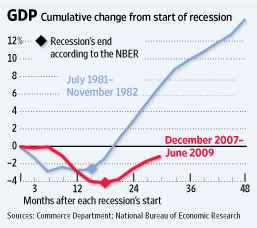It's official: The Great Recession ended 15 months ago, in June 2009. That was the word Monday from the economists at the National Bureau of Economic Research, the outfit that tracks the U.S. business cycle based on a variety of economic variables.
By their calculations, the downturn that began in December 2007 lasted 18 months, or the longest on record since the 43-month plunge of the Great Depression...the 2007-2009 downturn may have been painful but not extraordinary in historical context.
What is different about this period? The relative weakness of the economic recovery.

As the chart shows, in 1983 the recovery surpassed its previous peak in gross domestic product very rapidly from the recession's trough.
Growth rose by 4.5% in 1983, 7.2% in 1984 and 4.1% in 1985, and it kept climbing through the rest of the 1980s. (This is the kind of recovery you would expect coming out of a severe recession, since the deeper the trough the steeper the rebound.)
The current recovery peaked with 5% growth in the last quarter of 2009 but has decelerated in 2010—to 1.6% in the second quarter.
Such sluggish growth, in turn, has contributed to the sorry state of job creation, slow business investment and general market uneasiness. Uncertainty and higher costs that have undermined business and consumer confidence and slowed the economy's otherwise natural recuperative powers.
White House economists and liberals say the financial roots of this recession have made the recovery unusually difficult (i.e. Bush's fault), the fiscal stimulus saved the day, and thus we need more of it.
(WSJ.com)